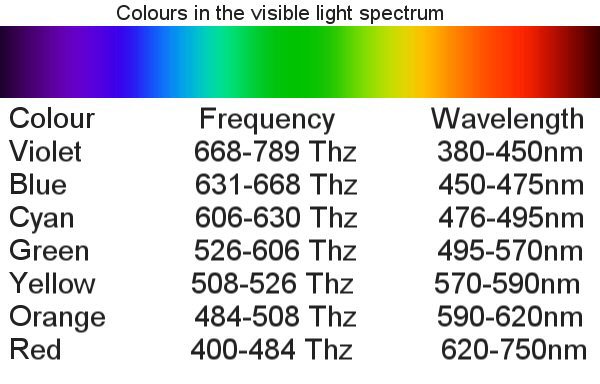
Infrared Light wavelengths and camera response is an importantant factor when choosing a CCTV camera or Webcam to use at night. The visible spectrum is the portion of the electromagnetic spectrum that is visible to (can be detected by) the human eye. Electromagnetic radiation in this range of wavelengths is called visible light or simply light. A typical human eye will respond to wavelengths from about 390 to 750nm (nano metres). Outside of this range our ability to see light falls away sharply as you can see from the table below.
Infra Red light in the 850nm wavelength is hard to see with the naked eye - but not impossible. However its very effective when used with CCTV cameras which can easily be produced with a sensitivity to light in this spectrum. Its also relatively easy to produce IR LED's which can operate at this wavelength.
IR Cut Filter On - All the IR light is filtered from the image so you get a lovely true colour daytime picture.

As this light is difficult to see with the naked eye its a good choice to use for semi covert illumination of CCTV images. We can only see a dull red glow around a typical infra red LED lamp operating at 850nm and then usually only if we are quite close to it and at the right angle. But to an IR sensitive CCTV camera this looks like a bright light and allows the camera to produce a good picture in total darkness. Of course the images produced are only in monochrome as we are seing light from only 1 precise wavelenght.
The reason that IR sensitive cameras can only produce a monochrome image when using IR lamps is that IR light is just one part of the spectrum and white light is made up from the combination of all the colours of the spectrum, as you probably know from the school experiments where passing white light through a Prism separates the colours producing a rainbow - all the colours of the spectrum for us to see.
As you see from the table IR light is above red in wavelength and begins to go outside our visibility range. IR Lamps for CCTV are produced in one of two wavelengths, the most common 840/850nm which is semi covert, and the 940nm wavelength which is even more difficult to see.
940nm is further from the visible spectrum and is much more difficult to see the source at night. 850nm is closer to the visible spectrum, and it's much easier to see a dull red glow in darkness. Also the sensitivity of most security cameras generally falls off from 850 nm to 940nm very quickly. So, if the camera sensor only has half the sensitivity at 940nm, then of course you will need twice the IR power at 940nm to get the same image as if you were using 850nm LED lamps.
Near-IR is really ideal for most CCTV cameras, with 940nm being on the tail end of the graph... so you have to use a LOT of 940nm light to make up for the decreased sensitivity. If you really need the more covert illumination available with a 940nm IR lamp then you will need to make sure that your cameras have a good response at 940nm or you will have to use at least twice the IR power to obtain the same results than if you were using the more common 850nm model lamps.
See how to calculate your IR Lamp requirements here - See our range of Infrared Lamps, covert and semi covert, here.
